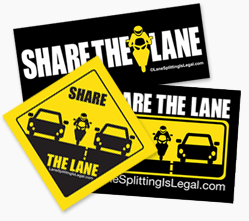The Bay Area Riders Forum, also known as “BARF,” is owned and run by Dennis “Budman” Kobza, who is a member of the CMSP (California Motorcycle Safety Program) Advisory Committee and also one of the few private citizens on the California Motorcycle Safety Committee. Budman has been a pivotal part of the lane splitting story in California since about 2009, and was first to stand up to an attempt by the DMV to ban lane splitting, leading to the first CHP lane splitting guidelines. You can read more about Budman’s role in California motorcycle safety in the April 2016 issue of CityBike Magazine.
On November 16th, tired of waiting for the CHP to release the guidelines authorized by AB 51, 2017, BARF released its own “Lane Splitting – Filtering – Sharing Guidelines,” created in collaboration with members of the BARF community, essentially more comprehensive guidelines for riders, by riders. The complete PDF is included below—here are the key points:
Lane Splitting – Filtering – Sharing Guidelines
Presented by Bay Area Riders Forum
Your safety depends on your good judgment:
- Don’t expect to be seen. Lane-splitters are hard to see and some drivers are distracted.
- Keep speed down so you have time and space to react to hazards.
- Avoid splitting next to large trucks and other wide vehicles. They reduce space available
and can be deadly in a crash. - Leave a margin for error, so when someone makes a mistake in the tight confines of the
splitting corridor, it may not end in a crash. - Respect other motorists. Commuting is a cheerless grind for everyone. Don’t make it
harder for them even if a few make it harder for you. - Watch for lane changes, they are a frequent cause of crashes.
Less risk:
- Lower traffic speed and speed differential.
- Wider lanes.
- Dense bumper-to-bumper traffic that limits ability of vehicles to change lanes.
- Left-most lanes farther from merging and exiting traffic.
More risk:
- Higher traffic speed or speed differential.
- Narrow lanes, wide vehicles.
- Gap in traffic that permits a quick lane change across the splitting corridor.
- Right side lanes near merging and exiting traffic.
- Intersections and crosswalks in the city.
- Following or being followed closely by another motorcycle.
- Night time or wet pavement.
Minimize your risk:
- Ride with your head and eyes up, looking well ahead.
- Anticipate the flow of traffic and predict hazards.
- Limit your speed to 10-15 miles per hour above surrounding traffic. This helps others to see you and gives you more time and space to react to hazards.
- Adjust your speed for road and weather conditions.
- Cover your brakes to reduce reaction time.
- Keep your hands and feet on the controls.
- Don’t split when traffic is moving at higher speeds. It raises risk but saves little time.
- Be skilled at maximum braking and swerving.

